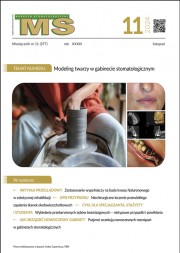Dostęp do tego artykułu jest płatny.
Zapraszamy do zakupu!
Po dokonaniu zakupu artykuł w postaci pliku PDF prześlemy bezpośrednio pod twój adres e-mail.
Manifestation of selected sleep disorders in the oral cavity – diagnosis and differentiation
Joanna Smardz, Helena Martynowicz, Grzegorz Mazur, Mieszko Więckiewicz
Streszczenie
Mechaniczne uszkodzenia zębów są jedną z częstszych przyczyn zgłaszania się pacjentów do gabinetów stomatologicznych, stanowiąc zarazem duże wyzwanie diagnostyczne. Patologiczne starcie i inne uszkodzenia zębów, często diagnozowane przez lekarzy stomatologów jako bruksizm, mogą być wywołane innym, motorycznym zaburzeniem snu, a mianowicie miokloniami ustno-żuchwowymi. Najdoskonalszą metodą diagnostyki i różnicowania bruksizmu w trakcie snu jest badanie polisomnograficzne, które umożliwia diagnostykę obu tych zaburzeń na poziomie elektromiografii (EMG), rejestracji dźwiękowej i wizualnej. Badanie to powinno być złotym standardem w diagnostyce bruksizmu w czasie snu.
Abstract
Mechanical wear of teeth is one of the most frequent reasons for patients to come to dental offices and at the same time a relevant diagnostic challenge. The tooth wear and other tooth damages often diagnosed by dentists as bruxism can be caused by another sleep movement disorder which is oromandibular myoclonus. The most accurate method of diagnosis and differentiation of sleep bruxism is a polysomnography, which enables the diagnosis of both these disorders at the level of electromyographic (EMG), audio and visual recording. This examination should be the golden standard in the diagnosis of sleep bruxism.
Hasła indeksowe: bruksizm, mioklonie, patologiczne starcie zębów, polisomnografia
Key words: bruxism, myoclonus, pathological tooth wear, polysomnography
PIŚMIENNICTWO
1. Lucas P.W., van Casteren A.: The wear and tear of teeth. Med. Princ. Pract., 2015, 24, Suppl. 1, 3-13, doi: 10.1159/000367976
2. Levrini L., Di Benedetto G., Raspanti M.: Dental wear: a scanning electron microscope study. Biomed. Res. Int., 2014, 2014, 340425, doi: 10.1155/2014/340425
3. Shellis R.P., Addy M.: The interactions between attrition, abrasion and erosion in tooth wear. Monogr. Oral. Sci., 2014, 25, 32-45, doi: 10.1159/000359936
4. Jonsgar C. i wsp.: Sleep bruxism in individuals with and without attrition-type tooth wear: an exploratory matched case-control electromyographic study. J. Dent., 2015, 43, 12, 1504-1510, doi: 10.1016/j.jdent.2015.10.002
5. Manfredini D. i wsp.: Current concepts of bruxism. Int. J. Prosthodont., 2017, 30, 5, 437-438, doi: 10.11607/ijp.5210
6. Klasser G.D., Rei N., Lavigne G.J.: Sleep bruxism etiology: the evolution of a changing paradigm. J. Can. Dent. Assoc., 2015, 81, f2.
7. Serra-Negra J.M. i wsp.: Signs, symptoms, parafunctions and associated factors of parent-reported sleep bruxism in children: a case-control study. Braz. Dent. J., 2012, 23, 6, 746-752.
8. Markiewicz M.R., Ohrbach R., McCall W.D. Jr.: Oral behaviors checklist: reliability of performance in targeted waking-state behaviors. J. Orofac. Pain., 2006, 20, 4, 306-316.
9. Rener-Sitar K. i wsp.: Exploration of dimensionality and psychometric properties of the Pittsburgh Sleep Quality Index in cases with temporomandibular disorders. Health Qual. Life Outcomes, 2014, 12, 10, doi: 10.1186/1477-7525-12-10
10. Richter P. i wsp.: On the validity of the Beck Depression Inventory. A review. Psychopathology, 1998, 31, 3, 160-168.
11. Ezzati A. i wsp.: Validation of the Perceived Stress Scale in a community sample of older adults. Int. J. Geriatr. Psychiatry, 2014, 29, 6, 645-652, doi: 10.1002/gps.4049
12. Schiffman E. i wsp.: Diagnostic Criteria for Temporomandibular Disorders (DC/TMD) for Clinical and Research Applications: recommendations of the International RDC/TMD Consortium Network* and Orofacial Pain Special Interest Group†. J. Oral Facial Pain Headache, 2014, 28, 1, 6-27, doi: 10.11607/jop.1151
13. Hirshkowitz M.: Polysomnography: understanding this technology’s past might guide future developments. IEEE Pulse, 2014, 5, 5, 26-28, doi: 10.1109/MPUL.2014.2339291
14. The National Center for Health Statistics (NCHS): International Classification of Diseases, Tenth Revision, Clinical Modification (ICD-10-CM), USA, 2015.
15. Manfredini D. i wsp.: Epidemiology of bruxism in adults: a systematic review of the literature. J. Orofac. Pain, 2013, 27, 2, 99-110, doi: 10.11607/jop.921
16. Kato T. i wsp.: Idiopathic myoclonus in the oromandibular region during sleep: a possible source of confusion in sleep bruxism diagnosis. Mov. Disord., 1999, 14, 5, 865-871.
17. Abe S. i wsp.: Sleep bruxism and oromandibular myoclonus in rapid eye movement sleep behavior disorder: a preliminary report. Sleep Med., 2013, 14, 10, 1024-1030, doi: 10.1016/j.sleep.2013.04.021
18. Donachie M.A., Walls A.W.: The tooth wear index: a flawed epidemiological tool in an ageing population group. Community Dent. Oral Epidemiol., 1996, 24, 2, 152-158.













